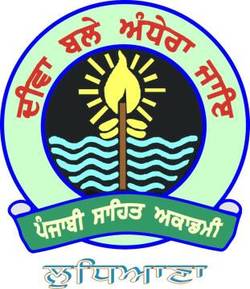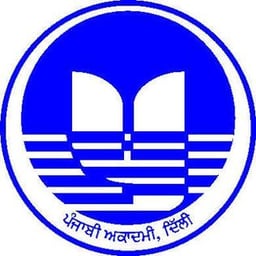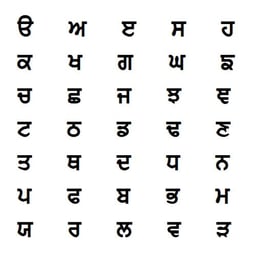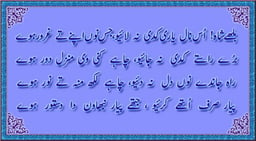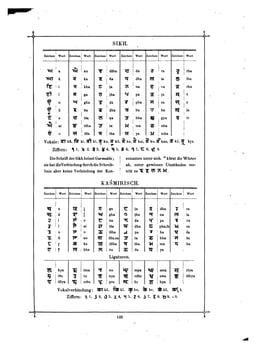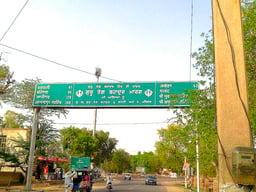Punjabi language
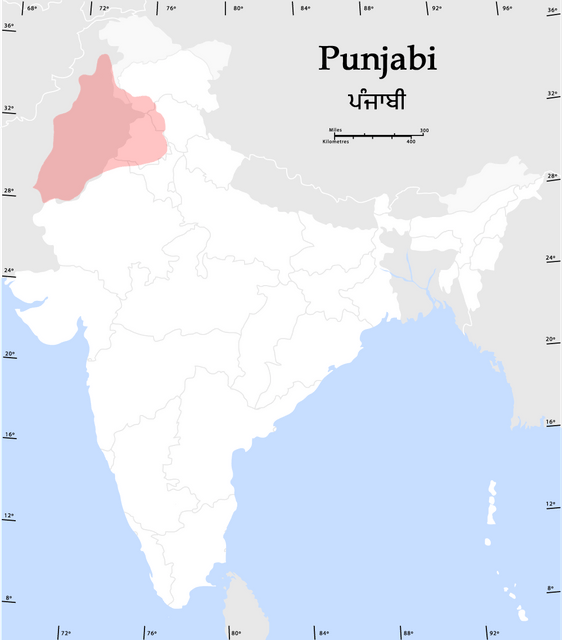
Punjabi language

| Punjabi | |
|---|---|
| ਪੰਜਾਬੀپن٘جابی | |
 'Punjabi' written in Shahmukhi (top) and Gurmukhi (bottom) scripts | |
| Pronunciation |
|
| Native to | India, Pakistan |
| Region | Punjab |
| Ethnicity | Punjabis |
Native speakers | 125 million (2011–2015)[1] |
Indo-European
| |
Standard forms | Majhi |
| Dialects |
|
Writing system |
|
| Official status | |
Official language in |
|
Recognised minority language in |
|
| Language codes | |
| ISO 639-1 | pa [111] |
| ISO 639-2 | pan [112] |
| ISO 639-3 | Either:pnb – Pakistani Punjabipan – Indian Punjabi |
| Glottolog | panj1256 [113]Punjabi[4] |
| Linguasphere | 59-AAF-e |
Punjabi (English: /pʌnˈdʒɑːbi/;[5] Punjabi: [pəɲˈdʒɑːbːi] ਪੰਜਾਬੀ / پنجابی pañjābī)[6] is an Indo-Aryan language with more than 125 million native speakers in the Indian subcontinent and around the world. It is the native language of the Punjabi people, an ethnolinguistic group of the cultural region called the Punjab, which encompasses northwest India and eastern Pakistan.
Punjabi is unusual among Indo-European languages in its use of lexical tone;[7][8][9] see § Tone below for examples. The Punjabi language is written in one of two alphabets: Shahmukhi or Gurmukhi. In the Punjab, both writing systems are used (a rare occurrence called synchronic digraphia): Shahmukhi is used mainly by Punjabi Muslims, Gurmukhi by Punjabi Sikhs and Devanagari by Punjabi Hindus.[6] There are over 31 types of sub-accents in the Punjabi language.[10]
| Punjabi | |
|---|---|
| ਪੰਜਾਬੀپن٘جابی | |
 'Punjabi' written in Shahmukhi (top) and Gurmukhi (bottom) scripts | |
| Pronunciation |
|
| Native to | India, Pakistan |
| Region | Punjab |
| Ethnicity | Punjabis |
Native speakers | 125 million (2011–2015)[1] |
Indo-European
| |
Standard forms | Majhi |
| Dialects |
|
Writing system |
|
| Official status | |
Official language in |
|
Recognised minority language in |
|
| Language codes | |
| ISO 639-1 | pa [111] |
| ISO 639-2 | pan [112] |
| ISO 639-3 | Either:pnb – Pakistani Punjabipan – Indian Punjabi |
| Glottolog | panj1256 [113]Punjabi[4] |
| Linguasphere | 59-AAF-e |
History
Etymology
The word Punjabi (sometimes spelled Panjabi) has been derived from the word Panj-āb, Persian for "Five Waters", referring to the five major eastern tributaries of the Indus River. The name of the region was introduced by the Turko-Persian conquerors[11] of South Asia and was a translation of the Sanskrit name for the region, Panchanada, which means "Land of the Five Rivers".[12][13] Panj is cognate with Sanskrit पञ्च (pañca) and Greek πέντε (pénte) "five", and "āb" is cognate with Sanskrit अप् (áp) and with the Av- of Avon. The historical Punjab region, now divided between India and Pakistan, is defined physiographically by the Indus River and these five tributaries. One of the five, the Beas River, is a tributary of another, the Sutlej.
Origin

Tilla Jogian, district Jehlum, Punjab, Pakistan a hilltop associated with many Nath jogis (considered among compilers of earlier Punjabi works)
Punjabi developed from Sanskrit through Prakrit languages and later Apabhraṃśa (Sanskrit: अपभ्रंश; corruption or corrupted speech)[14] From 600 BC Sanskrit gave birth to many regional languages in different parts of India. All these languages are called Prakrit (Sanskrit: प्राकृत prākṛta) collectively. Shauraseni Prakrit was one of these Prakrit languages, which was spoken in north and north-western India and Punjabi and western dialects of Hindi developed from this Prakrit. Later in northern India Shauraseni Prakrit gave rise to Shauraseni Aparbhsha, a descendant of Prakrit. Punjabi emerged as an Apabhramsha, a degenerated form of Prakrit, in the 7th century A.D. and became stable by the 10th century.[15][16][16][17][17] By the 10th century, many Nath poets were associated with earlier Punjabi works.
Arabic and Persian influence on Punjabi
Arabic and Persian influence in the historical Punjab region began with the late first millennium Muslim conquests on the Indian subcontinent.[18] The Persian language was introduced in the subcontinent a few centuries later by various Turko-Persian dynasties. Many Persian and Arabic words were incorporated in Punjabi.[19][20] It is noteworthy that the Hindustani language is divided into Hindi, with more Sanskritisation, and Urdu, with more Persianisation, but in Punjabi both Sanskrit and Persian words are used with a liberal approach to language. Later, it was influenced by Portuguese and English, though these influences have been minor in comparison to Persian and Arabic. However, in India, English words in the official language are more widespread than Hindi.[21]
| English | Gurmukhi-based (Punjab, India) | Shahmukhi-based (Punjab, Pakistan) |
|---|---|---|
| President | ਰਾਸ਼ਟਰਪਤੀ(*rāshtarpatī*) | صدرمملکت(*sadar-e mumlikat*) |
| Article | ਲੇਖ(*lēkh*) | مضمون(*mazmūn*) |
| Prime Minister | ਪਰਧਾਨ ਮੰਤਰੀ(*pardhān mantarī) | وزیراعظم(*wazīr-e aʿzam*) |
| Family | ਪਰਵਾਰ(*parvār) ਟੱਬਰ(*ṭabbar*) ਲਾਣਾ(*lāṇā*) | خاندان(*kḥāndān*) ٹبّر(*ṭabbar*) |
| Philosophy | ਫ਼ਲਸਫ਼ਾ(*falsafā*) ਦਰਸ਼ਨ(*darshan*) | فلسفہ(*falsafā*) |
| Capital | ਰਾਜਧਾਨੀ(*rājdhānī*) | دارالحکومت(*dārul hakūmat*) |
| Viewer | ਦਰਸ਼ਕ(*darshak*) | ناظرین(*nāzarīn*) |
| Listener | ਸਰੋਤਾ(*sarotā*) | سامع(*sāma'*) |
Note: In more formal contexts, hypercorrect Sanskritized versions of these words (ਪ੍ਰਧਾਨ pradhān for ਪਰਧਾਨ pardhān and ਪਰਿਵਾਰ parivār for ਪਰਵਾਰ parvār) may be used.
Modern times
Punjabi is spoken in many dialects in an area from Islamabad to Delhi. The Majhi dialect has been adopted as standard Punjabi in Pakistan and India for education, media etc. The Majhi dialect originated in the Majha region of the Punjab. The Majha region consists of several eastern districts of Pakistani Punjab and in India around Amritsar, Gurdaspur, and surrounding districts. The two most important cities in this area are Lahore and Amritsar.
In India technical words in Standard Punjabi are loaned from Sanskrit similarly to other major Indian languages, but it generously uses Arabic, Persian, and English words also in the official language. In India, Punjabi is written in the Gurmukhī script in offices, schools, and media. Gurmukhi is the official standard script for Punjabi, though it is often unofficially written in the Devanagari or Latin scripts due to influence from Hindi and English, India's two primary official languages at the Union-level.
In Pakistan, Punjabi is generally written using the Shahmukhī script, created from a modification of the Persian Nastaʿlīq script. In Pakistan, Punjabi loans technical words from Persian and Arabic languages, just like Urdu does.
Geographic distribution
Punjabi is the most widely spoken language in Pakistan, the eleventh -most widely spoken in India and spoken Punjabi diaspora in various countries.
Pakistan
Punjabi is the most widely spoken language in Pakistan, being the native language of 44% of its population. It is the provincial language in the Punjab Province.
| Year | Population of Pakistan | Percentage | Punjabi speakers |
|---|---|---|---|
| 1951 | 33,740,167 | 57.08% | 22,632,905 |
| 1961 | 42,880,378 | 56.39% | 28,468,282 |
| 1972 | 65,309,340 | 56.11% | 43,176,004 |
| 1981 | 84,253,644 | 48.17% | 40,584,980 |
| 1998 | 132,352,279 | 44.15% | 58,433,431 |
Beginning with the 1981 census, speakers of Saraiki and Hindko were no longer included in the total numbers for Punjabi, which could explain the apparent decrease.
India
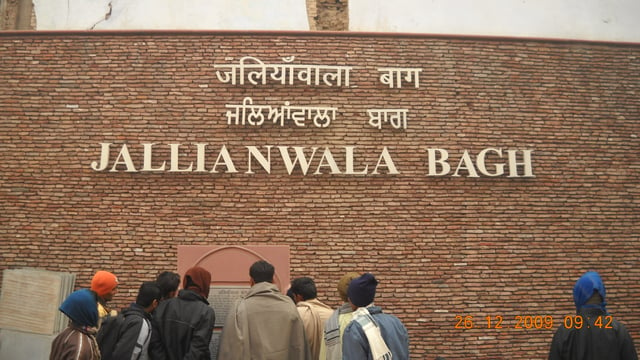
"Jallianwala Bagh" written in Hindi, Punjabi, and English in Amritsar, India.
Punjabi is spoken as a native language, second language, or third language by about 30 million people in India. Punjabi is the official language of the Indian state of Punjab. It is additional official in Haryana and Delhi. Some of its major urban centres in northern India are Ambala, Ludhiana, Patiala, Amritsar, Chandigarh, Jalandhar, Bathinda and Delhi.
| Year | Population of India | Punjabi speakers in India | Percentage |
|---|---|---|---|
| 1971 | 548,159,652 | 14,108,443 | 2.57% |
| 1981 | 665,287,849 | 19,611,199 | 2.95% |
| 1991 | 838,583,988 | 23,378,744 | 2.79% |
| 2001 | 1,028,610,328 | 29,102,477 | 2.83% |
Punjabi diaspora

Signs in Punjabi (along with English and Chinese) of New Democratic Party of British Columbia, Canada during 2009 elections
Punjabi is also spoken as a minority language in several other countries where Punjabi people have emigrated in large numbers, such as the United States, Australia, the United Kingdom, and Canada, where it is the fourth-most-commonly used language.[24] There were 76 million Punjabi speakers in Pakistan in 2008,[25] 33 million in India in 2011,[26] 368,000 in Canada in 2006,[27] and smaller numbers in other countries.
Major dialects
Majhi (Standard Punjabi)
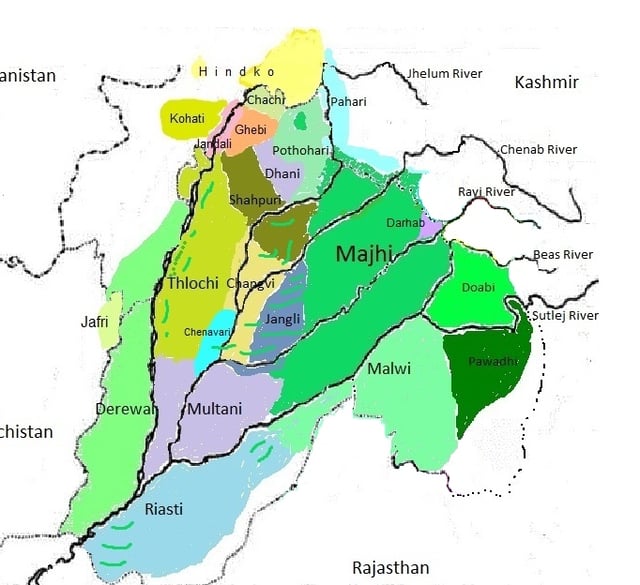
Punjabi dialects
The Majhi (ماجھی ਮਾਝੀ /'má:d͡ʒi:/) dialect spoken around Amritsar and Lahore is Punjabi's prestige dialect. Majhi is spoken in the heart of Punjab in the region of Majha, which spans Lahore, Amritsar, Gurdaspur, Kasur, Tarn Taran, Faisalabad, Nankana Sahib, Pathankot, Okara, Pakpattan, Sahiwal, Narowal, Sheikhupura, Sialkot, Chiniot, Gujranwala and Gujrat districts.
Majhi retains the nasal consonants /ŋ/ and /ɲ/, which have been superseded elsewhere by non-nasals /ɡ/ and /d͡ʒ/ respectively.
Shahpuri
Shahpuri dialect (also known as Sargodha dialect) is mostly spoken in Pakistani Punjab. Its name is derived from former Shahpur District (now Shahpur Tehsil, being part of Sargodha District). It is spoken throughout a widespread area, spoken in Sargodha and Khushab Districts and also spoken in neighbouring Mianwali and Bhakkar Districts. It is mainly spoken on western end of Indus River to Chenab river crossing Jhelum river.[28]
Malwai
Malwai is spoken in the southern part of Indian Punjab and also in Bahawalnagar and Vehari districts of Pakistan. Main areas are faridkot, Barnala, Ludhiana, Patiala, Ambala, Bathinda, Sangrur,[Mansa}, Malerkotla, Fazilka, Ferozepur, Moga. Malwa is the southern and central part of present-day Indian Punjab. It also includes the Punjabi speaking northern areas of Haryana, viz. Ambala, |Hissar], Narnaul etc. Not to be confused with the Malvi language, which shares its name.
Doabi
Doabi is spoken in both the Indian Punjab as well as parts of Pakistan Punjab owing to post-1947 migration of Muslim populace from East Punjab. The word "Do Aabi" means "the land between two rivers" and this dialect was historically spoken between the rivers of the Beas and the Sutlej in the region called Doaba. Regions it is presently spoken in include the Jalandhar, Hoshiarpur and Kapurthala districts in Indian Punjab, specifically in the areas known as the Dona and Manjki, as well as the Toba Tek Singh and Faisalabad districts in Pakistan Punjab where the dialect is known as Faisalabadi Punjabi.
Puadhi
Puadh is a region of Punjab and parts of Haryana between the Satluj and Ghaggar rivers. The part lying south, south-east and east of Rupnagar adjacent to Ambala District (Haryana) is Puadhi. The Puadh extends from that part of the Rupnagar District which lies near Satluj to beyond the Ghaggar river in the east up to Kala Amb, which is at the border of the states of Himachal pradesh and Haryana. Parts of Fatehgarh Sahib district, and parts of Patiala districts like Rajpura are also part of Puadh. The Puadhi dialect is spoken over a large area in present Punjab as well as Haryana. In Punjab, Kharar, Kurali, Ropar, Nurpurbedi, Morinda, Pail, Rajpura and Samrala are areas where Puadhi is spoken and the dialect area also includes Pinjore, Kalka, Ismailabad, Pehowa to Bangar area in Fatehabad district.
Jhangochi/Changvi
Jhangochi (جھنگوچی) dialect is spoken in Pakistani Punjab throughout a widespread area, starting from Khanewal and Jhang at both ends of Ravi and Chenab to Hafizabad district.
Jangli/Rachnavi
Jangli is a dialect of former nomad tribes of areas whose names are often suffixed with 'Bar' derived from jungle bar before irrigation system arrived in the start of the 20th century, for example, Sandal Bar, Kirana Bar, Neeli Bar, Ganji Bar. Former Layllpur and western half of Montgomary district used to speak this dialect.
Chenavari
West of Chenaab river in Jhang district of Pakistani Punjab the dialect of Jhangochi merges with Thalochi and resultant dialect is Chenavari. Name is derived from Chenaab river.
Phonology
Punjabi has a distinction between peripheral vowels, /i e ɛ a ɔ o u/, which in Gurmukhi script are written as if they were long (and are thus sometimes mistakenly called 'long' vowels), and centralized vowels, /ɪ ə ʊ/, which are written as if they were short.
| Front | Near-front | Central | Near-back | Back | |
|---|---|---|---|---|---|
| Close | iਈ | uਊ | |||
| Near-close | ɪਇ | ʊਉ | |||
| Close-mid | eਏ | oਓ | |||
| Mid | əਅ | ||||
| Open-mid | ɛਐ | ɔਔ | |||
| Open | aਆ |
The peripheral vowels have nasal analogues.
Tone
| Word | Transliteration | Tone | Meaning |
|---|---|---|---|
| ਘਰ | kàr | high-falling | house |
| ਕਰ੍ਹ | kár | low-rising | dandruff |
| ਕਰ | kar | level | do |
| ਘੋੜਾ | kòṛā | high-falling | horse |
| ਕੋੜ੍ਹਾ | kóṛā | low-rising | leper |
| ਕੋੜਾ | koṛā | level | whip |
Level tone is found in about 75% of words and is described by some as absence of tone.[32] There are also some words which are said to have rising tone in the first syllable and falling in the second. (Some writers describe this as a fourth tone.)[32] However, a recent acoustic study of six Punjabi speakers in America found no evidence of a separate falling tone following a medial consonant.[35]
ਮੋਢਾ móḍà (rising-falling) "shoulder"
It is considered that these tones arose when voiced aspirated consonants (gh, jh, ḍh, dh, bh) lost their aspiration. At the beginning of a word they became voiceless unaspirated consonants (k, c, ṭ, t, p) followed by a high-falling tone; medially or finally they became voiced unaspirated consonants (g, j, ḍ, d, b), preceded by a low-rising tone. (The development of a high-falling tone apparently did not take place in every word, but only in those which historically had a long vowel.)[34]
The presence of an [h] (although the [h] is now silent or very weakly pronounced except word-initially) word-finally (and sometimes medially) also often causes a rising tone before it, for example cá(h) "tea".[36]
The Gurmukhi script which was developed in the 16th century has separate letters for voiced aspirated sounds, so it is thought that the change in pronunciation of the consonants and development of tones may have taken place since that time.[34]
Some other languages in Pakistan have also been found to have tonal distinctions, including Burushaski, Gujari, Hindko, Kalami, Shina, and Torwali.[37]
Grammar

Gurmukhi alphabet including vowels
Punjabi distinguishes two genders, two numbers, and five cases of direct, oblique, vocative, ablative, and locative/instrumental. The ablative occurs only in the singular, in free variation with oblique case plus ablative postposition, and the locative/instrumental is usually confined to set adverbial expressions.[40]
Adjectives, when declinable, are marked for the gender, number, and case of the nouns they qualify.[41] There is also a T-V distinction. Upon the inflectional case is built a system of particles known as postpositions, which parallel English's prepositions. It is their use with a noun or verb that is what necessitates the noun or verb taking the oblique case, and it is with them that the locus of grammatical function or "case-marking" then lies. The Punjabi verbal system is largely structured around a combination of aspect and tense/mood. Like the nominal system, the Punjabi verb takes a single inflectional suffix, and is often followed by successive layers of elements like auxiliary verbs and postpositions to the right of the lexical base.[42]
The grammar of the Punjabi language concerns the word order, case marking, verb conjugation, and other morphological and syntactic structures of the Punjabi language.
Writing systems
Punjabi has two major writing systems in use: Gurmukhī, which is a Brahmic script derived from the Laṇḍā script,[43] and Shahmukhi, which is an Arabic script. The term Gurmukhī derives from the term for the followers of Sikhism attested in Sikh scriptures, Gurmukhs (literally, those with their faces (mukh) toward the Guru, as opposed to a Manmukh, or facing base desires); the script thus came to be known as Gurmukhī, "the script of those guided by the Guru."[44] The word Gurmukhi is often also held to mean "from the Guru's mouth",[45] and following this precedent, Shahmukhi means "from the King's mouth".[46]
In the Punjab province of Pakistan, the script used is Shahmukhī and differs from the Urdu alphabet in having four additional letters.[47] In the Indian states of Punjab, Haryana and Delhi and other parts of India, the Gurmukhī script is generally used for writing Punjabi.[47] Historically, various local Brahmic scripts including Laṇḍā were also in use.[48]
Sample text
This sample text was taken from the Punjabi Wikipedia article on Lahore.
Gurmukhi: ਲਹੌਰ ਪਾਕਿਸਤਾਨੀ ਪੰਜਾਬ ਦੀ ਰਾਜਧਾਨੀ ਹੈ । ਲੋਕ ਗਿਣਤੀ ਦੇ ਨਾਲ ਕਰਾਚੀ ਤੋਂ ਬਾਅਦ ਲਹੌਰ ਦੂਜਾ ਸਭ ਤੋਂ ਵੱਡਾ ਸ਼ਹਿਰ ਹੈ । ਲਹੌਰ ਪਾਕਿਸਤਾਨ ਦਾ ਸਿਆਸੀ, ਰਹਤਲੀ ਅਤੇ ਪੜ੍ਹਾਈ ਦਾ ਗੜ੍ਹ ਹੈ ਅਤੇ ਇਸੇ ਲਈ ਇਹਨੂੰ ਪਾਕਿਸਤਾਨ ਦਾ ਦਿਲ ਵੀ ਕਿਹਾ ਜਾਂਦਾ ਹੈ । ਲਹੌਰ ਰਾਵੀ ਦਰਿਆ ਦੇ ਕੰਢੇ 'ਤੇ ਵਸਦਾ ਹੈ । ਇਸਦੀ ਲੋਕ ਗਿਣਤੀ ਇੱਕ ਕਰੋੜ ਦੇ ਨੇੜੇ ਹੈ |
Shahmukhi:
Transliteration: lahaur pākistānī panjāb dī rājtā̀ni ài. lok giṇtī de nāḷ karācī tõ bāad lahaur dūjā sáb tõ vaḍḍā šáir ài. lahaur pākistān dā siāsī, rátalī ate paṛā̀ī dā gáṛ ài te ise laī ínū̃ pākistān dā dil vī kihā jāndā ài. lahaur rāvī dariā de káṇḍè te vasdā ài. isdī lok giṇtī ikk karoṛ de neṛe ài.
IPA: [ləɦɔːɾᵊ paːkɪst̪aːniː pənd͡ʒaːbᵊ d̪iː ɾaːd͡ʒᵊt̪àːni: ɦɛ̀ː ‖ lo:kᵊ ɡɪɳᵊt̪iː d̪e naːlᵊ kəɾaːt͡ʃiː t̪õ: baːəd̪ᵊ ləɦɔːɾᵊ d̪uːd͡ʒaː sə́bᵊ t̪õ: ʋːəɖ:aː ʃəɦɪɾ ɦɛ̀ː ‖ ləɦɔːɾᵊ paːkɪst̪aːnᵊ d̪aː sɪaːsiː | ɾə́ɦt̪əliː ət̪e: pəɽàːiː d̪aː ɡə́ɽ ɦɛ̀ː ət̪e: ɪse: ləiː ɪ́ɦnū̃ paːkɪst̪aːnᵊ d̪aː d̪ɪlᵊ ʋiː kɪɦaː d͡ʒa:nd̪aː ɛ̀ː ‖ ləɦɔːɾᵊ ɾaːʋiː d̪əɾɪa: d̪e: kə́ɳɖe: t̪e: ʋəsᵊd̪aː ɛ̀ː ‖ ɪsᵊd̪iː lo:kᵊ ɡɪɳᵊt̪iː ɪkːᵊ kəɾo:ɽᵊ d̪e: ne:ɽe: ɛ̀ː ‖]
Translation: Lahore is the capital city of Pakistani Punjab. After Karachi, Lahore is the second largest city. Lahore is Pakistan's political, cultural, and educational hub, and so it is also said to be the heart of Pakistan. Lahore lies on the bank of the Ravi River. Its population is close to ten million people.
Literature development
Medieval era, Mughal and Sikh period

Sufi poets have enriched Punjabi literature
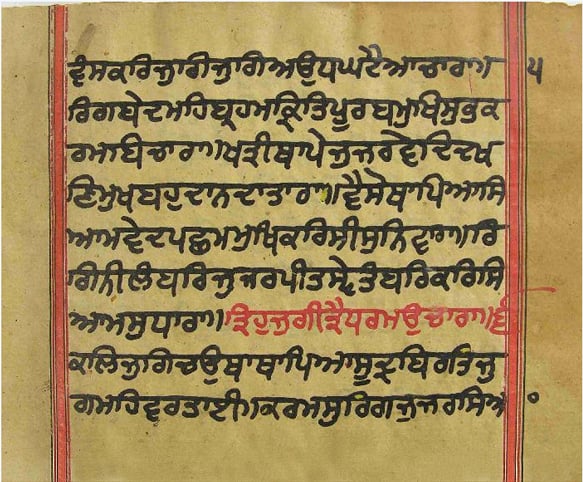
Varan Gyan Ratnavali by 16th-century historian Bhai Gurdas.
The earliest Punjabi literature is found in the fragments of writings of the 11th Nath yogis (ਨਾਥਯੋਗੀ, ناتھیوگی) Gorakshanath and Charpatnah which is primarily spiritual and mystical in tone.
Fariduddin Ganjshakar (1179-1266) is generally recognised as the first major poet of the Punjabi language.[49] Roughly from the 12th century to the 19th century, many great Sufi saints and poets preached in the Punjabi language, the most prominent being Bulleh Shah. Punjabi Sufi poetry also developed under Shah Hussain (1538–1599), Sultan Bahu (1630–1691), Shah Sharaf (1640–1724), Ali Haider (1690–1785), Waris Shah (1722–1798), Saleh Muhammad Safoori (1747-1826), Mian Muhammad Baksh (1830-1907) and Khwaja Ghulam Farid (1845-1901).
The Janamsakhis (ਜਨਮਸਾਖੀ, جنم ساکھی), stories on the life and legend of Guru Nanak (1469–1539), are early examples of Punjabi prose literature.
The Punjabi language is famous for its rich literature of qisse (ਕਿੱਸੇ, قصّے), most of the which are about love, passion, betrayal, sacrifice, social values and a common man's revolt against a larger system. The qissa of Heer Ranjha by Waris Shah (1706–1798) is among the most popular of Punjabi qissas. Other popular stories include Sohni Mahiwal by Fazal Shah, Mirza Sahiban by Hafiz Barkhudar (1658–1707), Sassui Punnhun by Hashim Shah (c. 1735–c. 1843), and Qissa Puran Bhagat by Qadaryar (1802–1892).
Heroic ballads known as Vaar (ਵਾਰ, وار) enjoy a rich oral tradition in Punjabi. Famous Vaars are Chandi di Var (1666–1708), Nadir Shah Di Vaar by Najabat and the Jangnama of Shah Mohammad (1780–1862).[51]
British Raj era and post-independence period
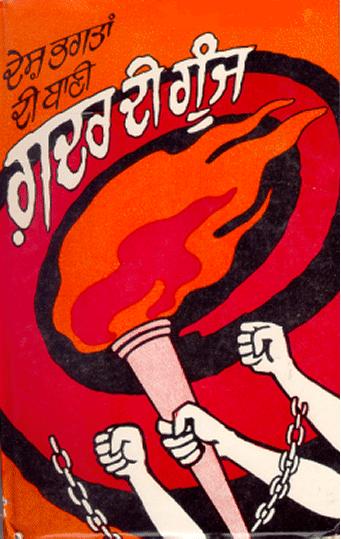
Ghadar di Gunj 1913, newspaper in Punjabi of Ghadar Party, US-based Indian revolutionary party.
The Victorian novel, Elizabethan drama, free verse and Modernism entered Punjabi literature through the introduction of British education during the Raj. Nanak Singh (1897–1971), Vir Singh, Ishwar Nanda, Amrita Pritam (1919–2005), Puran Singh (1881–1931), Dhani Ram Chatrik (1876–1957), Diwan Singh (1897–1944) and Ustad Daman (1911–1984), Mohan Singh (1905–78) and Shareef Kunjahi are some legendary Punjabi writers of this period. After independence of Pakistan and India Najm Hossein Syed, Fakhar Zaman and Afzal Ahsan Randhawa, Shafqat Tanvir Mirza, Ahmad Salim, and Najm Hosain Syed, Munir Niazi, Pir Hadi abdul Mannan enriched Punjabi literature in Pakistan, whereas Amrita Pritam (1919–2005), Jaswant Singh Rahi (1930–1996), Shiv Kumar Batalvi (1936–1973), Surjit Patar (1944–) and Pash (1950–1988) are some of the more prominent poets and writers from India.
Status
Despite Punjabi's rich literary history, it was not until 1947 that it would be recognized as an official language. Previous governments in the area of the Punjab had favoured Persian, Hindustani, or even earlier standardised versions of local registers as the language of the court or government. After the annexation of the Sikh Empire by the British East India Company following the Second Anglo-Sikh War in 1849, the British policy of establishing a uniform language for administration was expanded into the Punjab. The British Empire employed Hindi and Urdu in its administration of North-Central and North-West India, while in the North-East of India, Bengali was used as the language of administration. Despite its lack of official sanction, the Punjabi language continued to flourish as an instrument of cultural production, with rich literary traditions continuing until modern times. The Sikh religion, with its Gurmukhi script, played a special role in standardising and providing education in the language via Gurdwaras, while writers of all religions continued to produce poetry, prose, and literature in the language.
In India, Punjabi is one of the 22 scheduled languages of India. It is the first official language of the Indian State of Punjab. Punjabi also has second language official status in Delhi along with Urdu, and in Haryana. In Pakistan, no regional ethnic language has been granted official status at the national level, and as such Punjabi is not an official language at the national level, even though it is the most spoken language in Pakistan after Urdu, the national language of Pakistan. It is, however, the official provincial language of Punjab, Pakistan, the second largest and the most populous province of Pakistan as well as in Islamabad Capital Territory. The only two official national languages in Pakistan are Urdu and English, which are considered the lingua francas of Pakistan.
In Pakistan
When Pakistan was created in 1947, although Punjabi was the majority language in West Pakistan and Bengali the majority in East Pakistan and Pakistan as whole, English and Urdu were chosen as the national languages. The selection of Urdu was due to its association with South Asian Muslim nationalism and because the leaders of the new nation wanted a unifying national language instead of promoting one ethnic group's language over another. Broadcasting in Punjabi language by Pakistan Broadcasting Corporation decreased on TV and radio after 1947. Article 251 of the Constitution of Pakistan declares that these two languages would be the only official languages at the national level, while provincial governments would be allowed to make provisions for the use of other languages.[52] However, in the 1950s the constitution was amended to include the Bengali language. Eventually, Punjabi was granted status as a provincial language in Punjab Province, while the Sindhi language was given official status in 1972 after 1972 Language violence in Sindh.
Despite gaining official recognition at the provincial level, Punjabi is not a language of instruction for primary or secondary school students in Punjab Province (unlike Sindhi and Pashto in other provinces).[53] Pupils in secondary schools can choose the language as an elective, while Punjabi instruction or study remains rare in higher education. One notable example is the teaching of Punjabi language and literature by the University of the Punjab in Lahore which began in 1970 with the establishment of its Punjabi Department.[54][55]
In the cultural sphere, there are many books, plays, and songs being written or produced in the Punjabi-language in Pakistan. Until the 1970s, there were a large number of Punjabi-language films being produced by the Lollywood film industry, however since then Urdu has become a much more dominant language in film production. Additionally, television channels in Punjab Province (centred on the Lahore area) are broadcast in Urdu. The preeminence of Urdu in both broadcasting and the Lollywood film industry is seen by critics as being detrimental to the health of the language.[56][57]
Language demands in Punjab province
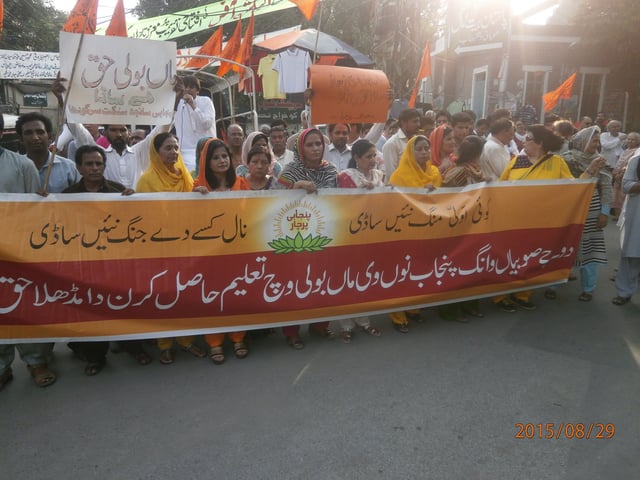
A demonstration by Punjabis at Lahore, Pakistan, demanding to make Punjabi as official language of instruction in schools of the Punjab.
The use of Urdu and English as the near exclusive languages of broadcasting, the public sector, and formal education have led some to fear that Punjabi in Pakistan is being relegated to a low-status language and that it is being denied an environment where it can flourish. Several prominent educational leaders, researchers, and social commentators have echoed the opinion that the intentional promotion of Urdu and the continued denial of any official sanction or recognition of the Punjabi language amounts to a process of "Urdu-isation" that is detrimental to the health of the Punjabi language[58][59][60] In August 2015, the Pakistan Academy of Letters, International Writer’s Council (IWC) and World Punjabi Congress (WPC) organised the Khawaja Farid Conference and demanded that a Punjabi-language university should be established in Lahore and that Punjabi language should be declared as the medium of instruction at the primary level.[61][62] In September 2015, a case was filed in Supreme Court of Pakistan against Government of Punjab, Pakistan as it did not take any step to implement the Punjabi language in the province.[63][64] Additionally, several thousand Punjabis gather in Lahore every year on International Mother Language Day.
Hafiz Saeed, chief of Jama'at-ud-Da'wah (JuD) has questioned Pakistan's decision to adopt Urdu as its national language in a country where majority of people speak Punjabi language, citing his interpretation of Islamic doctrine as encouraging education in the mother-tongue.[65] The list of thinktanks, political organisations, cultural projects, and individuals that demand authorities at the national and provincial level to promote the use of the language in the public and official spheres includes:
Cultural and research institutes: Punjabi Adabi Board, the Khoj Garh Research Centre, Punjabi Prachar, Institute for Peace and Secular Studies, Adbi Sangat, Khaaksaar Tehreek, Saanjh, Maan Boli Research Centre, Punjabi Sangat Pakistan, Punjabi Markaz, Sver International
Trade unions and youth groups: Punjabi Writers Forum, National Students Federation, Punjabi Union-Pakistan, Punjabi National Conference, National Youth Forum, Punjabi Writers Forum, National Students Federation, Punjabi Union, Pakistan, and the Punjabi National Conference.
Notable activists include Tariq Jatala, Farhad Iqbal, Diep Saeeda, Khalil Ojla, Tajammul Kaleem, Afzal Sahir, Jamil Ahmad Paul, Mazhar Tirmazi, Mushtaq Sufi, Biya Je, Tohid Ahmad Chattha and Bilal Shaker Kahaloon, Nazeer Kahut[66][67][68]
In India
At the federal level, Punjabi has official status via the Eighth Schedule to the Indian Constitution,[69] earned after the Punjabi Suba movement of the 1950s.[70] At the state level, Punjabi is the sole official language of the state of Punjab, while it has secondary official status in the states of Haryana and Delhi.[71]
Both federal and state laws specify the use of Punjabi in the field of education. The state of Punjab uses the Three Language Formula, and Punjabi is required to be either the medium of instruction, or one of the three languages learnt in all schools in Punjab.[72] Punjabi is also a compulsory language in Haryana,[73] and other states with a significant Punjabi speaking minority are required to offer Punjabi medium education.
There are vibrant Punjabi language movie and news industries in India, however Punjabi serials have had a much smaller presence within the last few decades in television due to market forces.[74] Despite Punjabi having far greater official recognition in India, "where the Punjabi language is officially admitted in all necessary social functions, while in Pakistan it is used only in a few radio and TV programs," attitudes of the English-educated elite towards the language are ambivalent as they are in neighboring Pakistan.[69] [] There are also claims of state apathy towards the language in non-Punjabi majority areas like Haryana and Delhi.[75][76][77]
Advocacy
Punjabi University, It was established on 30 April 1962, and is only the second university in the world to be named after a language, after Hebrew University of Jerusalem. The Research Centre for Punjabi Language Technology, Punjabi University, Patiala.[78] It is working for development of core technologies for Punjabi, Digitisation of basic materials, online Punjabi teaching, developing software for office use in Punjabi, provinding common platform to Punjabi cyber community.[79] Punjabipedia, an online encyclopaedia was also launched by Patiala university in 2014.[80][81]
The Dhahan Prize was created award literary works produced in Punjabi around the world. The Prize encourages new writing by awarding $25,000 CDN annually to one "best book of fiction" published in either of the two Punjabi scripts, Gurmukhi or Shahmukhi. Two second prizes of $5,000 CDN are also awarded, with the provision that both scripts are represented among the three winners. The Dhahan Prize is awarded by Canada India Education Society (CIES).[82]
Governmental academies and institutes
The Punjabi Sahit academy, Ludhiana, established in 1954[83][84] is supported by the Punjab state government and works exclusively for promotion of the Punjabi language, as does the Punjabi academy in Delhi.[85] The Jammu and Kashmir academy of art, culture and literature[86] in Jammu and Kashmir, India works for Punjabi and other regional languages like Urdu, Dogri, Gojri etc. Institutions in neighboring states[87] as well as in Lahore, Pakistan[88] also advocate for the language.
Software
Software are available for Punjabi language for almost all platforms. These software are mainly in Gurmukhi script. Nowadays, nearly all Punjabi newspapers, magazines, journals, and periodicals are composed on computers via various Punjabi software programmes, the most widespread of which is InPage Desktop Publishing package. Microsoft has included Punjabi language support in all new versions of Windows and both Windows Vista, Mircrsoft Office 2007, 2010 and 2013, are available in Punjabi through the Language Interface Pack[89] support. Most Linux Desktop distributions allow the easy installation of Punjabi support and translations as well.[90] Apple implemented the Punjabi language keyboard across Mobile devices.[91] Google also provides many applications in Punjabi, like Google Search,[92] Google Translate[93] and Google Punjabi Input Tools.[94]
